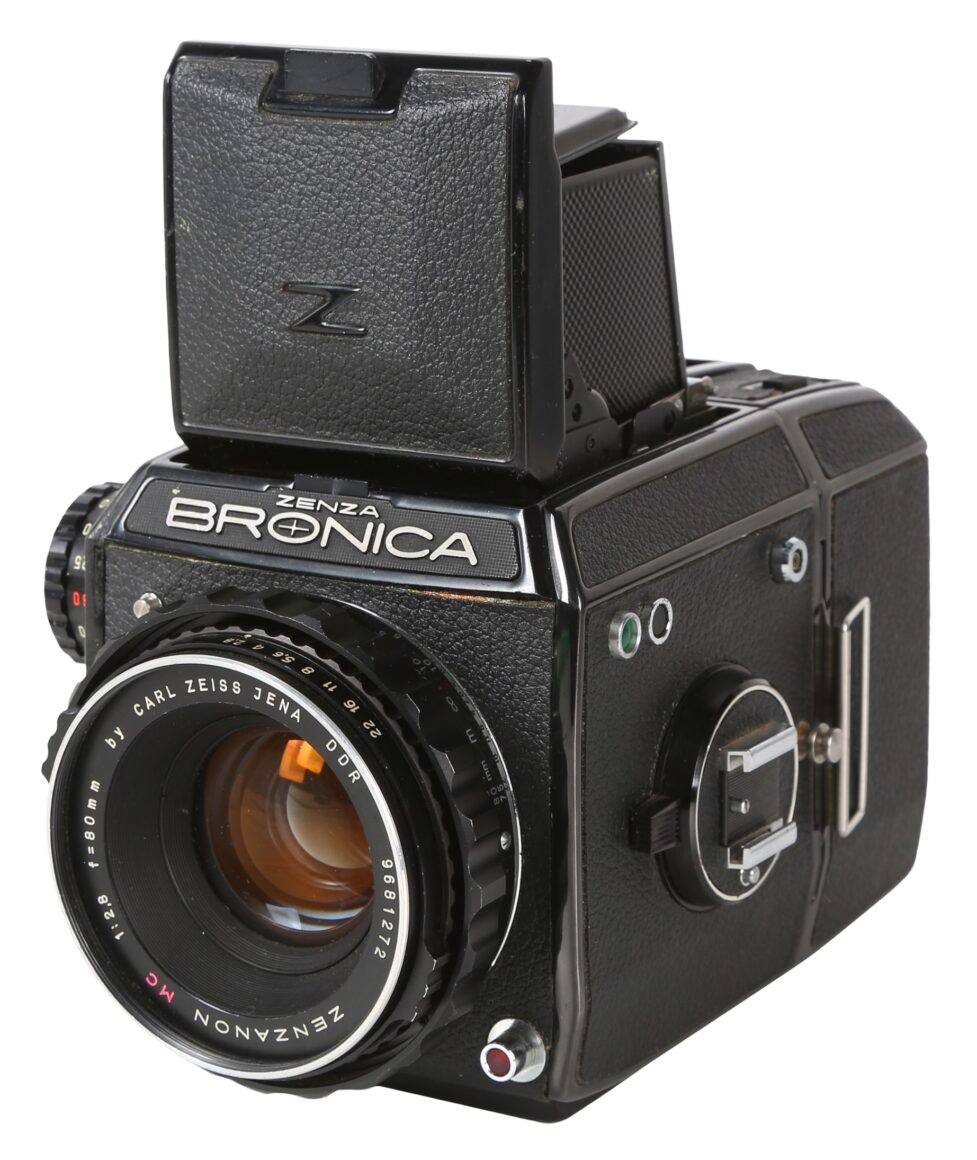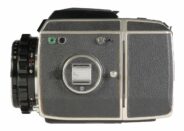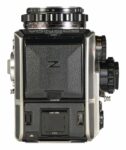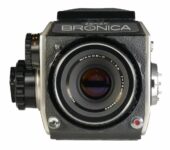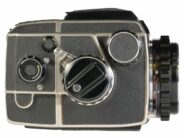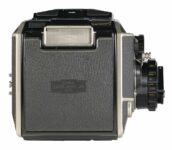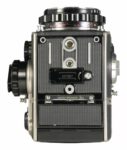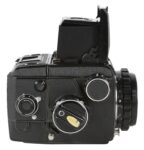Bronica EC
Medium format MF film SLR camera
Specification
| Production details: | |
| Announced: | April 1972 |
| System: | ● Bronica (1959) |
| Format: | |
| Maximum format: | Medium format 6x6 |
| Film type: | 120 roll film |
| 220 roll film | |
| Mount and Flange focal distance: | Bronica [102mm] |
| Shutter: | |
| Type: | Focal-plane |
| Model: | Electronically controlled |
| Speeds: | 4 - 1/1000 + B |
| Exposure: | |
| Exposure metering: | None |
| Exposure modes: | Manual |
| Physical characteristics: | |
| Weight: | 1980g |
| Dimensions: | 139x117x170mm |
Manufacturer description #1
The Electronic Connection
It's the connection between solid state circuitry and consistent exposure accuracy. Speeds, four full seconds through 1/1000th, permanently, repeatably accurate.
The connection that links the accessory Electro-Controlled Meter/Finder with the shutter, for continuously-variable through-the-lens exposure control.
The connection that doesn't exist between the built-in focal plane shutter and 10 interchangeable lenses.* One electronically-controlled shutter for all 10 lenses means perfectly consistent shutter speeds with all 10 lenses.
Three reasons why Bronica EC delivers most consistently accurate exposures in 2 1/4 photography. Plus the image quality of Nikkor and Zenzanon lenses.
A complete system of accessories. Bronica EC. Electronic. Accurate.
Manufacturer description #2
The New Bronica EC
The Fantastic Journey
An odyssey within the new Bronica EC
Ours is a journey with a mission.
A voyage through today and tomorrow.
Come with us beyond the conventional to preview the new era of 2 1/4 photography. A remarkable new camera with an electronically controlled shutter and a host of other meaningful photographic innovations.
The Bronica EC.
Let's journey inside and examine its inner most workings. Discover why it very much represents the current state of the 2 1/4 art.
Into the lenses
The EC was born with 12 of the finest lenses in the world. From 40mm ultra-wide angle thru 1200mm telephoto. And seven of them boast the famous Nikkor name. Every one with instant reopen diaphragm. One even has its own synchro shutter. Provides electronic flash synch from 1 sec. to 1/500th. Yet all with prices below what you've come to expect for prime 2 1/4 optics.
The magic mirror that splits
Finder blackout is an anachronism no modern photographer can accept - and naturally, the EC has an instant-return mirror. But the fascination is in how it works. Ingeniously, it is split. The top section flips up, covers the finder. The two sections effectively counter-balance each other. So you get that all-important visual follow-through with no danger of mirror-induced vibration. Even at slow shutter speeds. And the mirror is extra large, so there's no corner cutoff with extremely long lenses.
The meter that links without linkage
The EC Electro-Controlled Meter/Finder is a revolution in inself. Slip it on in place of the standard hood (itself unique with a patented sequential folding mechanism), and it connects electronically with the shutter. No mechanical linkage is needed! Simply pre-set the lens aperture (and program meter with lens and film speed information), center the needle within the meter's shutter speed dial. Or you can do it the other way around. ASA range is 16 to 3200.
Through the looking glass and into the electronic age
You will hear no grating of cams, no grinding of gears in the EC shutter control. Because there are none. In fact, there are no moving parts!
The EC focal plane shutter is electronically timed. So it is reliable, repeatable and matchlessly accurate in any extreme of temperature and even after years of use. The shutter is incredibly efficient, and actually crosses the 2 1/4'' aperture faster than most 35's cross their 1 1/3'' opening! There are 13 shutter speeds, from 4 seconds through 1/1000th, plus B, and electronic flash synch at 1/60th.
The back with the unloseable dark slide
120/220 backs for the EC (there are 2 1/4 square and 1 5/8 x 2 1/4 versions) incorporate such feeatures as an easy-reading magnified film counter, double exposure capability and conversion from 120 to 220 and back by simply setting the exposure counter. But, according to many, the most important of all, despite its amazing simplicity, the unique darkslide storage pocket. A Polaroid back is also available, of course.
Born with a complete system
Beyond lenses and backs, a complete system of accessoires is already available for the EC, including four instantly interchangeable viewfinder screens, eyelevel prism, magnifying and sports finders, closeup equipment including the distance to closeup focusing Bronica Bellows, a copying stand, and more.
This is the Bronica EC. A combination of the best of 35mm with the best of 2 1/4. For tomorrow's pro, the future begins now.
Manufacturer description #3
The New Bronica EC
Created with an Electronically-Controlled Shutter
The exciting new Bronica EC looks like a handsome, but conventional 2 1/4 square slr on the outside. But on the inside, it's a whole different world.
Where most focal plane shutter cameras have a clock-like mechanism of cams and gears that control the shutter, the EC has no mechanism at all. Instead, resistors, capacitors, an electronic circuit board. Because the shutter is electronically-controlled.
This means you get an unusually wide choice of shutter speeds; 4 full seconds through 1/1000th. But more importantly, it means total repeatability, utter reliability. Cams and gears are metal. No matter how precisely they are made, they expand and contract in extremes of heat and cold. And they wear. Inevitably, there are variations, inconsistencies, breakdowns.
But an electronic circuit has no moving parts. Nothing to wear out. Temperature changes have no significant effect. The EC electronics will give precisely the same impulses to the shutter every winter, every summer for as many years as you use the camera. To each of the lenses you use. Change lenses, change climates, shoot and shoot. Exposures will be perfectly consistent.
And there's more, much more. There is an ingenious split instant-return mirror that moves off in two opposite directions to cancel out vibration. An accessory Electro-Controlled Meter/Finder that can change shutter speeds directly because the shutter is electronically timed.
A fast-acting crank that winds the film and cocks the shutter in two quick turns. A unique synch socket that locks regular PC cords firmly in place. [Electronic flash synch is 1/60th].
Interchangeable 120/220 backs that change from 120 to 220 with the turn of a dial, have double exposure provision - in both 2 1/4 square and 2 1/4 x 1 1/2 formats (and incorporate a handy dark-slide pocket!). In fact, there's a complete system, including 12 nikkor and zenzanon lenses, 40mm through 1200mm.
Manufacturer description #4
BRONICA EC
The Bronica EC was introduced in March of 1972 and represents a new generation of Bronica design.
The primary innovation of this model is stepped electronically controlled shutter speeds from 4 seconds to 1/1000 second. The external evidence of this unique feature is the oblong battery compartment in the base of the camera, and the button and battery check light on the top left side of the body.
In addition, the EC offers double exposure control (on the film back on the right side), mirror lock up (lever on the left side), locking PC terminal, dark slide storage pocket, split mirror, interchangeable focusing screens and many other features.
All lenses of the Bronica system fit the EC, as does the extension tube set. A new series of grips, #82041 L grip and #82042 pistol grip fit both the EC and S2A. The EC has its own bellows, which due to the longer mirror has a different mounting plate than the S2A version, and its own series of prisms, finders and backs.
Manufacturer description #5
The use of solid-state electronics to control shutter speeds gives the Bronica EC photographer an assurance of shutter accuracy and exposure constancy vastly superior to any previously available. And its implications for future advances go far beyond these immediate benefits.
Along with this unique shutter, the Bronica EC provides numerous other important innovations. New facilities include interchangeable finder screens, a unique split mirror, locking synch terminal and sequentially-folding finder hood, to name a few.
Naturally, the EC retains such traditional Bronica advantages as automatic mirror and diaphragm action and true modular system versatility. A new array of interchangeable finders - including a shutter-coupled thru-the-Iens meter system - plus film backs and other accessories has been designed specifically for use with the EC. At the same time, it accepts the full, present complement of Bronica lenses with its incomparable Nikkor and Zenzanon optics, as well as present lens attachments and extension tubes.
Nothing has been spared to make the Bronica EC the most reliable, most ruggedly built camera of its type. Yet it handles with a speed and ease that would do credit to a fine "35", while offering the advantages of convenient ground-glass composition and easily enlargeable 2-1/4 x 2-1/4 format. In short, the Bronica EC combines the most advanced technology and widest photographic capabilities in a truly magnificent camera.
Manufacturer description #6
The Zenza Bronica EC is the result of human-engineering research for easier handling. It features a high-precision electronically control shutter mechanism and complete system-camera compatibility.
a. For easy operation, all graduations on the Bronica EC can be seen from above the camera at a glance, and controls are concentrated on the right-hand side of the body. Many special safety mechanisms have been built-in.
b. The mirror is a two-piece, main-mirror and sub-mirror combination to preclude mirror shock, usually one of the disadvantages of a large-format camera. A two-piece mirror yields a complete field of view in the viewfinder (top, bottom, and both sides) when using telephoto lenses with a longer than standard focal length.
c. The shutter is a highly-accurate, electronic-control type especially suitable for color photography. Shutter speeds are extremely accurate.
d. Film back interchangeability permits switchover during mid-roll, from color to black and white film, freely. The film back and camera body function automatically as an integral. The lens bayonet mount is identical to the type used for other Zenza Bronica cameras, permitting lenses to be interchanged without difficulty.
f. The waist-level finder opens and closes by a one-finger action, and the focusing screen and magnifiers can be interchanged freely.
g. Electronic flash synchronization at 1/60 sec. Once the plug of the electronic flash unit is inserted into the camera body, it is locked into place and cannot be removed unless the release lock is depressed. This insures perfect contact at all times.
h. Other Bronica EC features: Mirror locking mechanism, multiple exposure feature, and a camera body designed to readily permit mounting of a TTL exposure meter, the latter insuring the photographer a camera that is designed to display the full merits of system photography.
***
TYPE: 2-1/4" x 2-1/4" (6cm x 6cm) single lens reflex camera. Daylight film change type.
PICTURE SIZE: 55.2 x 55.2mm.
FILM: 120 film (12 exposures) and 220 film (24 exposures).
STANDARD LENS: Nikkor 75mm f/2.8 (Zenzanon 100mm f/2.8 lens is also available as standard).
LENS MOUNT: Large bayonet mount for 105, 300, 400, 600, 800, and 1200mm lenses. Small bayonet mount for 40, 50, 75, 100, 150, and 200mm lenses removable. Screw mount (57mm diameter, 1mm pitch) for close-up rings (fixed).
FOCUSING: Helical focusing system with parallel movement (stroke 14mm). Focusing ring is removable.
DIAPHRAGM: Fully automatic, equi-spaced graduations. Intermediate settings are possible. Permits depth of field previewing.
SHUTTER: Electronically timed focal plane shutter. Shutter speeds B-4-2-1-1/2-1/4-1/8-1/15-1/30-1/60-1/125-1/250-1/500-1/1000. Shutter button locking permits time exposure. Shutter is powered with a 6-volt silver oxide battery (Eveready No. 544, UCAR No. 544, or Mallory No. PX-28). Battery checker system (button and light) provided.
FILM BACK: Daylight film back change type, fully coupled as an integral to the camera body. Provided with multiple exposure lever, automatic reset exposure counter, film type indicator frame, selector dial for 12/24 exposures, manual film winder, dark slide pocket, and dark slide.
REFLEX MIRROR: Two-piece, up and down, instant return type. Mirror locking device.
FILM SHUTTER KNOB/CRANK: Film shutter winding is possible by two turns of the crank or by winding the knob.
WAIST-LEVEL FINDER: Interchangeable focusing hood type. One-action open/close operation. Magnifiers are interchangeable.
FOCUSING SCREEN: Interchangeable. Types available: with mat center, with microprism center, with split-image prism, and with fine mat finish.
SYNCHRONIZATION: Automatic switchover synchronization system. X (electronic flash): B-4 to 1/60 sec. FP: B-4 to 1/15-1/125 to 1/1000 sec. M: B-4 to 1/15 sec. F: B-4 to 1/30 sec. Self-locking socket.
OTHER PARTICULARS: Accessory shoe, shutter button safety lock, tripod mounting holes (1/4" diameter and 3/8" diameter) provided.
